2006 FORD FUSION (AMERICAS) brake
[x] Cancel search: brakePage 217 of 264
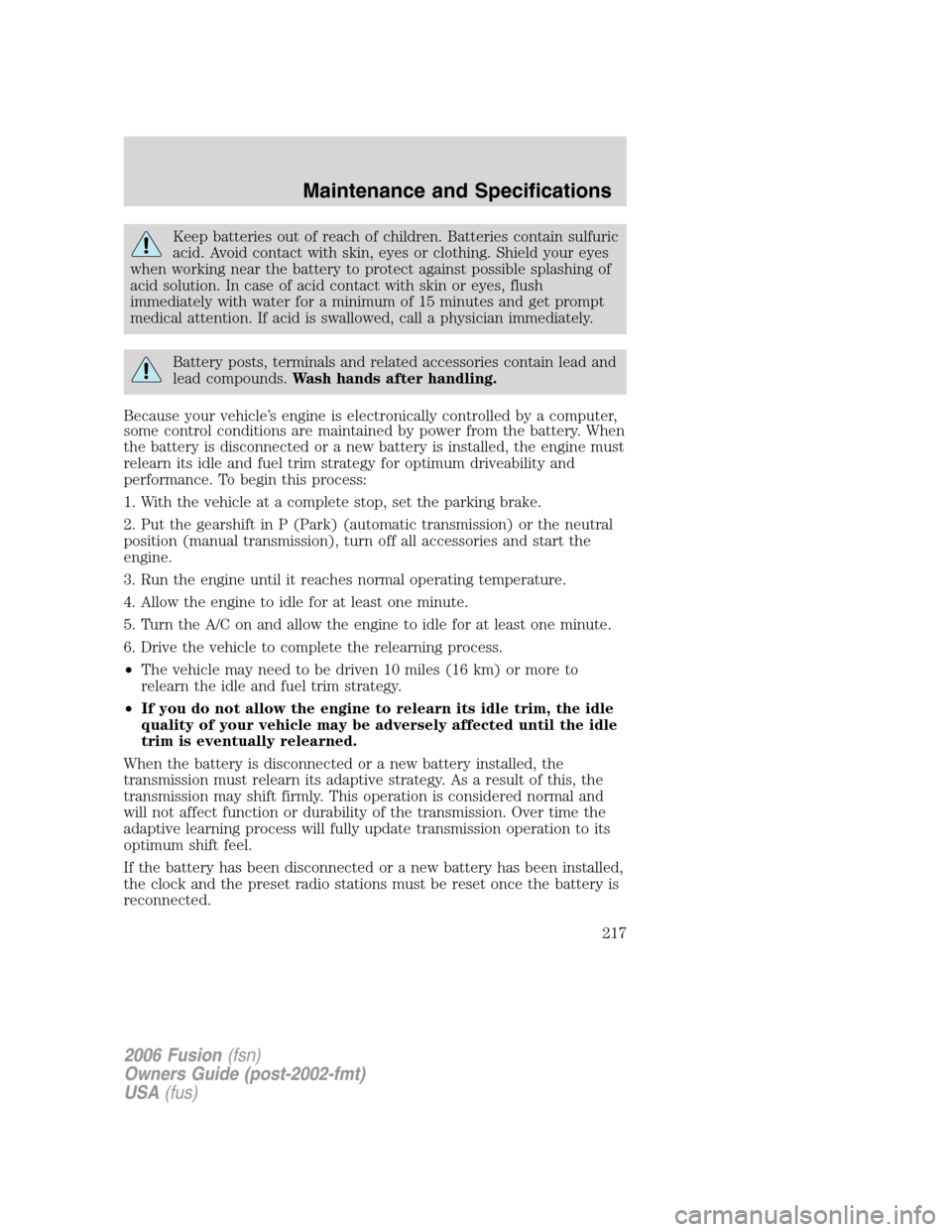
Keep batteries out of reach of children. Batteries contain sulfuric
acid. Avoid contact with skin, eyes or clothing. Shield your eyes
when working near the battery to protect against possible splashing of
acid solution. In case of acid contact with skin or eyes, flush
immediately with water for a minimum of 15 minutes and get prompt
medical attention. If acid is swallowed, call a physician immediately.
Battery posts, terminals and related accessories contain lead and
lead compounds.Wash hands after handling.
Because your vehicle’s engine is electronically controlled by a computer,
some control conditions are maintained by power from the battery. When
the battery is disconnected or a new battery is installed, the engine must
relearn its idle and fuel trim strategy for optimum driveability and
performance. To begin this process:
1. With the vehicle at a complete stop, set the parking brake.
2. Put the gearshift in P (Park) (automatic transmission) or the neutral
position (manual transmission), turn off all accessories and start the
engine.
3. Run the engine until it reaches normal operating temperature.
4. Allow the engine to idle for at least one minute.
5. Turn the A/C on and allow the engine to idle for at least one minute.
6. Drive the vehicle to complete the relearning process.
•The vehicle may need to be driven 10 miles (16 km) or more to
relearn the idle and fuel trim strategy.
•If you do not allow the engine to relearn its idle trim, the idle
quality of your vehicle may be adversely affected until the idle
trim is eventually relearned.
When the battery is disconnected or a new battery installed, the
transmission must relearn its adaptive strategy. As a result of this, the
transmission may shift firmly. This operation is considered normal and
will not affect function or durability of the transmission. Over time the
adaptive learning process will fully update transmission operation to its
optimum shift feel.
If the battery has been disconnected or a new battery has been installed,
the clock and the preset radio stations must be reset once the battery is
reconnected.
2006 Fusion(fsn)
Owners Guide (post-2002-fmt)
USA(fus)
Maintenance and Specifications
217
Page 231 of 264

•Resting your foot on the brake pedal while driving may reduce fuel
economy.
•Combine errands and minimize stop-and-go driving.
Maintenance
•Keep tires properly inflated and use only recommended size.
•Operating a vehicle with the wheels out of alignment will reduce fuel
economy.
•Use recommended engine oil. Refer toLubricant specificationsin
this chapter.
•Perform all regularly scheduled maintenance items. Follow the
recommended maintenance schedule and owner maintenance checks
found inscheduled maintenance information.
Conditions
•Heavily loading a vehicle may reduce fuel economy at any speed.
•Carrying unnecessary weight may reduce fuel economy (approximately
1 mpg [0.4 km/L] is lost for every 400 lb [180 kg] of weight carried).
•Adding certain accessories to your vehicle (for example bug
deflectors, rollbars/light bars, running boards, ski/luggage racks) may
reduce fuel economy.
•Using fuel blended with alcohol may lower fuel economy.
•Fuel economy may decrease with lower temperatures during the first
8–10 miles (12–16 km) of driving.
•Driving on flat terrain offers improved fuel economy as compared to
driving on hilly terrain.
•Transmissions give their best fuel economy when operated in the top
cruise gear and with steady pressure on the gas pedal.
•Close windows for high speed driving.
EPA window sticker
Every new vehicle should have the EPA window sticker. Contact your
authorized dealer if the window sticker is not supplied with your vehicle.
The EPA window sticker should be your guide for the fuel economy
comparisons with other vehicles.
It is important to note the box in the lower left corner of the window
sticker. These numbers represent the Range of MPG (L/100 km)
expected on the vehicle under optimum conditions. Your fuel economy
may vary depending upon the method of operation and conditions.
2006 Fusion(fsn)
Owners Guide (post-2002-fmt)
USA(fus)
Maintenance and Specifications
231
Page 235 of 264

1. Start the engine and let it run until it reaches normal operating
temperature (the engine coolant temperature gauge indicator will be
near the center of the normal area between H and C).
2. While the engine idles, turn the steering wheel left and right several
times.
3. Turn the engine off.
4. Check the fluid level in the reservoir. It should be between the
MIN/MAX or upper and lower lines. Do not add fluid if the level is in this
range.
5. If the fluid is low, add fluid in small amounts, continuously checking
the level until it reaches the range between the MIN/MAX or upper and
lower lines. Be sure to put the cap back on the reservoir.
BRAKE/CLUTCH FLUID
Brake and clutch systems are supplied from the same reservoir.
The fluid level will drop slowly as
the brakes wear, and will rise when
the brake components are replaced.
Fluid levels between the “MIN” and
“MAX” lines are within the normal
operating range; there is no need to
add fluid. If the fluid levels are
outside of the normal operating
range the performance of your
brake system could be
compromised; seek service from
your authorized dealer immediately.
TRANSAXLE FLUID
Checking 5–speed automatic transaxle fluid (If equipped)
Refer to yourscheduled maintenance informationfor scheduled
intervals for fluid checks and changes. Your transaxle does not consume
fluid. However, the fluid level should be checked if the transaxle is not
working properly, i.e., if the transaxle slips or shifts slowly or if you
notice some sign of fluid leakage.
Automatic transmission fluid expands when warmed. To obtain an
accurate fluid check, drive the vehicle until it is warmed up
(approximately 20 miles [30 km]). If your vehicle has been
MAX
MIN
2006 Fusion(fsn)
Owners Guide (post-2002-fmt)
USA(fus)
Maintenance and Specifications
235
Page 236 of 264
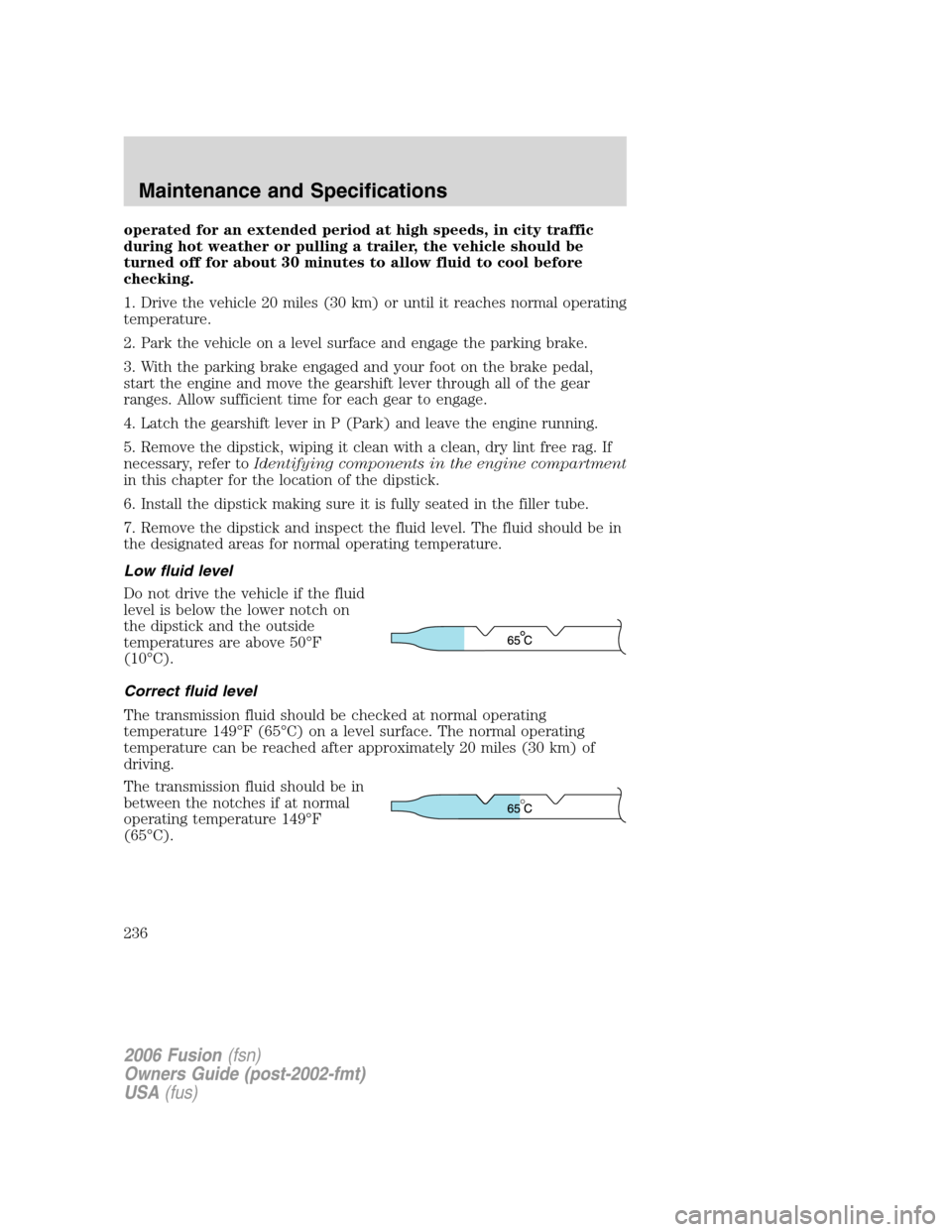
operated for an extended period at high speeds, in city traffic
during hot weather or pulling a trailer, the vehicle should be
turned off for about 30 minutes to allow fluid to cool before
checking.
1. Drive the vehicle 20 miles (30 km) or until it reaches normal operating
temperature.
2. Park the vehicle on a level surface and engage the parking brake.
3. With the parking brake engaged and your foot on the brake pedal,
start the engine and move the gearshift lever through all of the gear
ranges. Allow sufficient time for each gear to engage.
4. Latch the gearshift lever in P (Park) and leave the engine running.
5. Remove the dipstick, wiping it clean with a clean, dry lint free rag. If
necessary, refer toIdentifying components in the engine compartment
in this chapter for the location of the dipstick.
6. Install the dipstick making sure it is fully seated in the filler tube.
7. Remove the dipstick and inspect the fluid level. The fluid should be in
the designated areas for normal operating temperature.
Low fluid level
Do not drive the vehicle if the fluid
level is below the lower notch on
the dipstick and the outside
temperatures are above 50°F
(10°C).
Correct fluid level
The transmission fluid should be checked at normal operating
temperature 149°F (65°C) on a level surface. The normal operating
temperature can be reached after approximately 20 miles (30 km) of
driving.
The transmission fluid should be in
between the notches if at normal
operating temperature 149°F
(65°C).
2006 Fusion(fsn)
Owners Guide (post-2002-fmt)
USA(fus)
Maintenance and Specifications
236
Page 238 of 264
![FORD FUSION (AMERICAS) 2006 1.G Owners Manual Checking automatic transmission fluid at normal operating
temperature (140°F-158°F [60°C-70°C])
Automatic transmission fluid expands when warmed. To obtain an
accurate fluid check, drive the vehic FORD FUSION (AMERICAS) 2006 1.G Owners Manual Checking automatic transmission fluid at normal operating
temperature (140°F-158°F [60°C-70°C])
Automatic transmission fluid expands when warmed. To obtain an
accurate fluid check, drive the vehic](/manual-img/11/5179/w960_5179-237.png)
Checking automatic transmission fluid at normal operating
temperature (140°F-158°F [60°C-70°C])
Automatic transmission fluid expands when warmed. To obtain an
accurate fluid check, drive the vehicle until it is warmed up
(approximately 20 miles [30 km]) until the engine coolant gauge
indicates normal operating temperature. If your vehicle has been
operated for an extended period at high speeds, in city traffic
during hot weather or pulling a trailer, the vehicle should be
turned off for about 30 minutes to allow fluid to cool before
checking.
1. Drive the vehicle 20 miles (30 km) or until the coolant guage indicates
normal operating temperature.
2. Park the vehicle on a level surface and engage the parking brake.
3. With the parking brake engaged and your foot on the brake pedal,
start the engine and move the gearshift lever through all of the gear
ranges. Allow sufficient time for each gear to engage (approximately
10–15 seconds in each position).
4. Move the gearshift lever to P (Park) and leave the engine running.
5. Remove the dipstick, wiping it clean with a clean, dry, lint-free rag. If
necessary, refer toIdentifying components in the engine compartment
in this chapter for the location of the dipstick.
6. Install the dipstick making sure it is fully seated in the filler tube.
7. Remove the dipstick and inspect
the fluid level. The fluid should read
within the hot range on the dipstick
if at normal operating temperature
(140°F-158°F [60°C-70°C]).
Checking automatic transmission fluid at cool temperature
(59°F-77°F [15°C-25°C])
If a fluid check is necessary at a low
fluid temperature (59°F-77°F
[15°C-25°C]), perform the check
using the cold range on the dipstick.
However, the fluid must be
re-checked at the proper fluid temperature.
2006 Fusion(fsn)
Owners Guide (post-2002-fmt)
USA(fus)
Maintenance and Specifications
238
Page 240 of 264
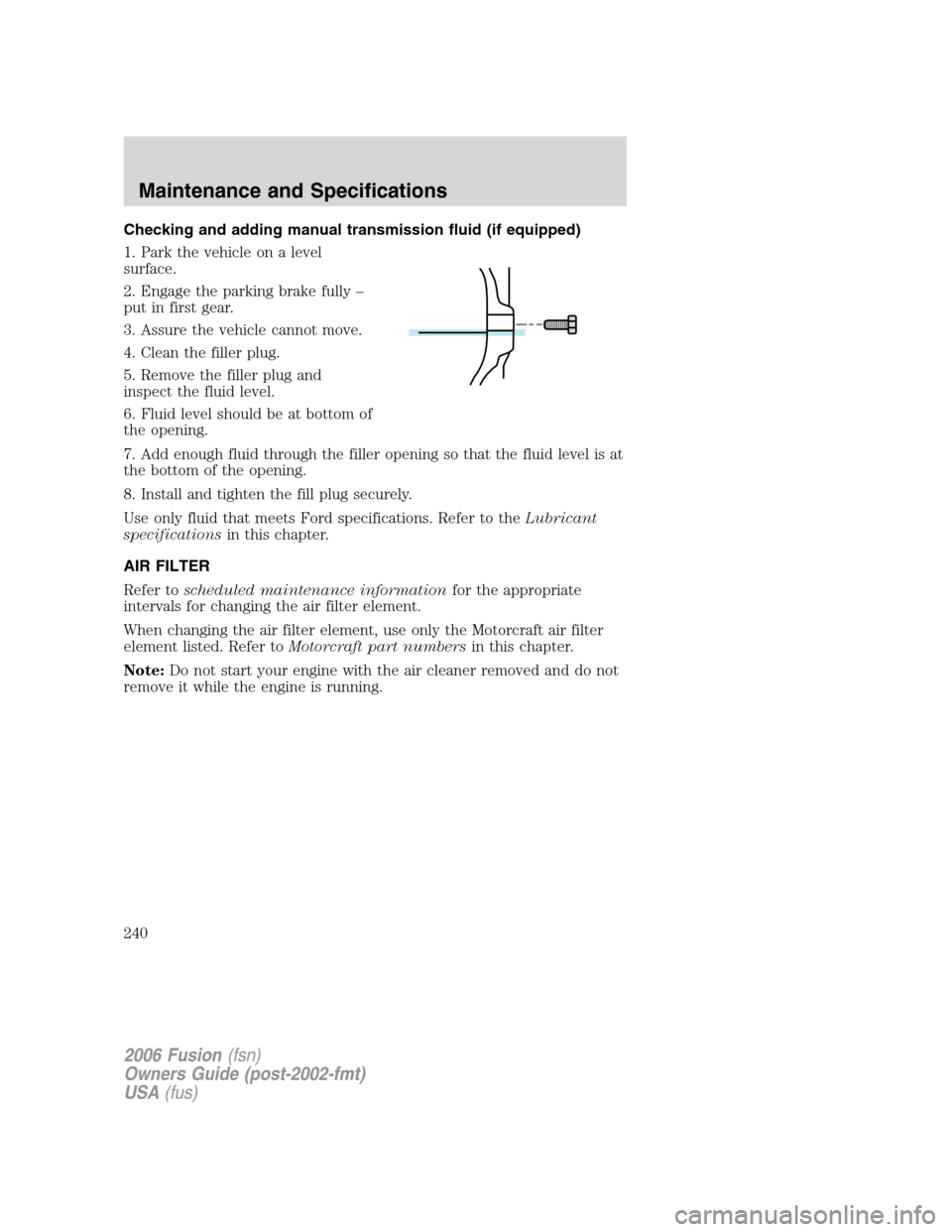
Checking and adding manual transmission fluid (if equipped)
1. Park the vehicle on a level
surface.
2. Engage the parking brake fully –
put in first gear.
3. Assure the vehicle cannot move.
4. Clean the filler plug.
5. Remove the filler plug and
inspect the fluid level.
6. Fluid level should be at bottom of
the opening.
7. Add enough fluid through the filler opening so that the fluid level is at
the bottom of the opening.
8. Install and tighten the fill plug securely.
Use only fluid that meets Ford specifications. Refer to theLubricant
specificationsin this chapter.
AIR FILTER
Refer toscheduled maintenance informationfor the appropriate
intervals for changing the air filter element.
When changing the air filter element, use only the Motorcraft air filter
element listed. Refer toMotorcraft part numbersin this chapter.
Note:Do not start your engine with the air cleaner removed and do not
remove it while the engine is running.
2006 Fusion(fsn)
Owners Guide (post-2002-fmt)
USA(fus)
Maintenance and Specifications
240
Page 243 of 264
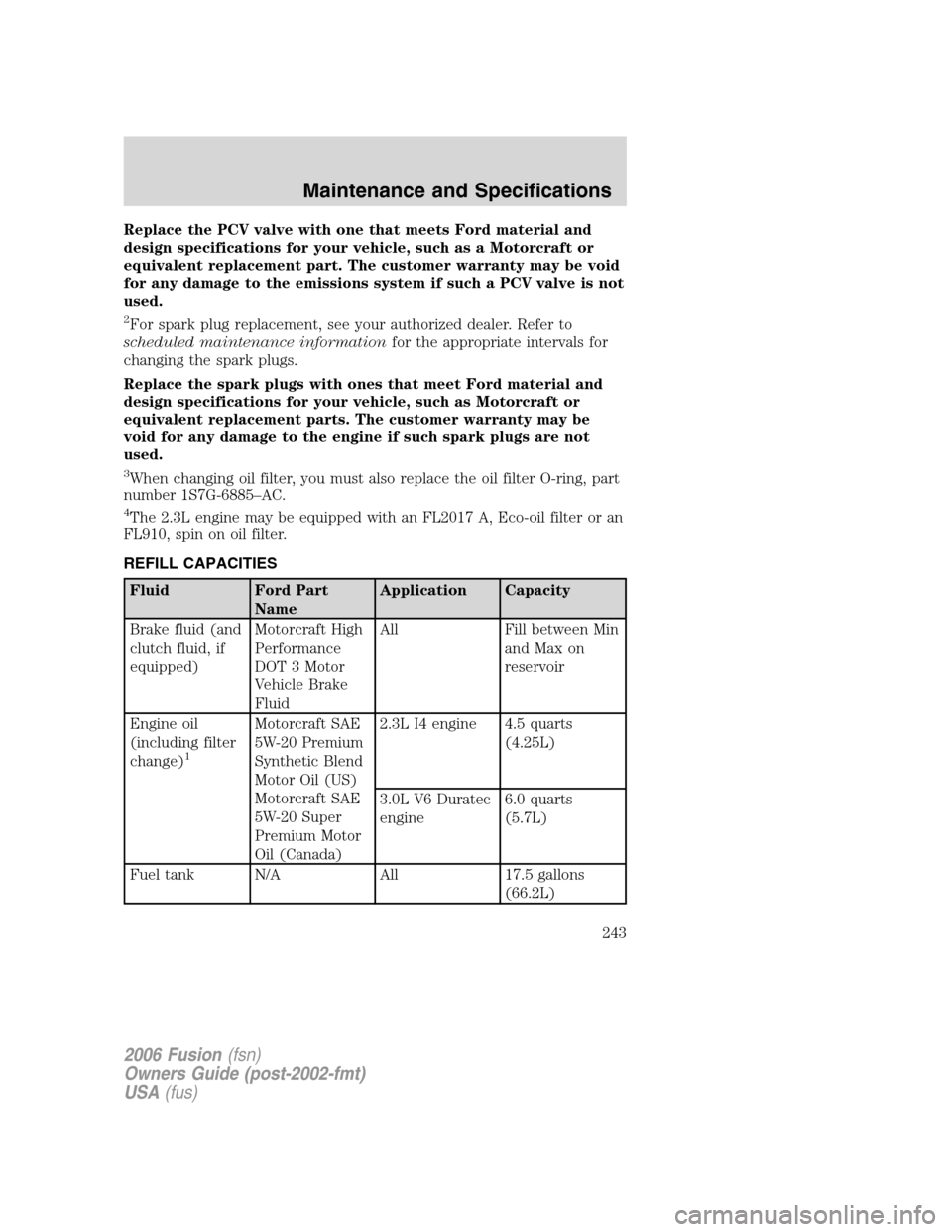
Replace the PCV valve with one that meets Ford material and
design specifications for your vehicle, such as a Motorcraft or
equivalent replacement part. The customer warranty may be void
for any damage to the emissions system if such a PCV valve is not
used.
2For spark plug replacement, see your authorized dealer. Refer to
scheduled maintenance informationfor the appropriate intervals for
changing the spark plugs.
Replace the spark plugs with ones that meet Ford material and
design specifications for your vehicle, such as Motorcraft or
equivalent replacement parts. The customer warranty may be
void for any damage to the engine if such spark plugs are not
used.
3When changing oil filter, you must also replace the oil filter O-ring, part
number 1S7G-6885–AC.
4The 2.3L engine may be equipped with an FL2017 A, Eco-oil filter or an
FL910, spin on oil filter.
REFILL CAPACITIES
Fluid Ford Part
NameApplication Capacity
Brake fluid (and
clutch fluid, if
equipped)Motorcraft High
Performance
DOT 3 Motor
Vehicle Brake
FluidAll Fill between Min
and Max on
reservoir
Engine oil
(including filter
change)
1
Motorcraft SAE
5W-20 Premium
Synthetic Blend
Motor Oil (US)
Motorcraft SAE
5W-20 Super
Premium Motor
Oil (Canada)2.3L I4 engine 4.5 quarts
(4.25L)
3.0L V6 Duratec
engine6.0 quarts
(5.7L)
Fuel tank N/A All 17.5 gallons
(66.2L)
2006 Fusion(fsn)
Owners Guide (post-2002-fmt)
USA(fus)
Maintenance and Specifications
243
Page 245 of 264
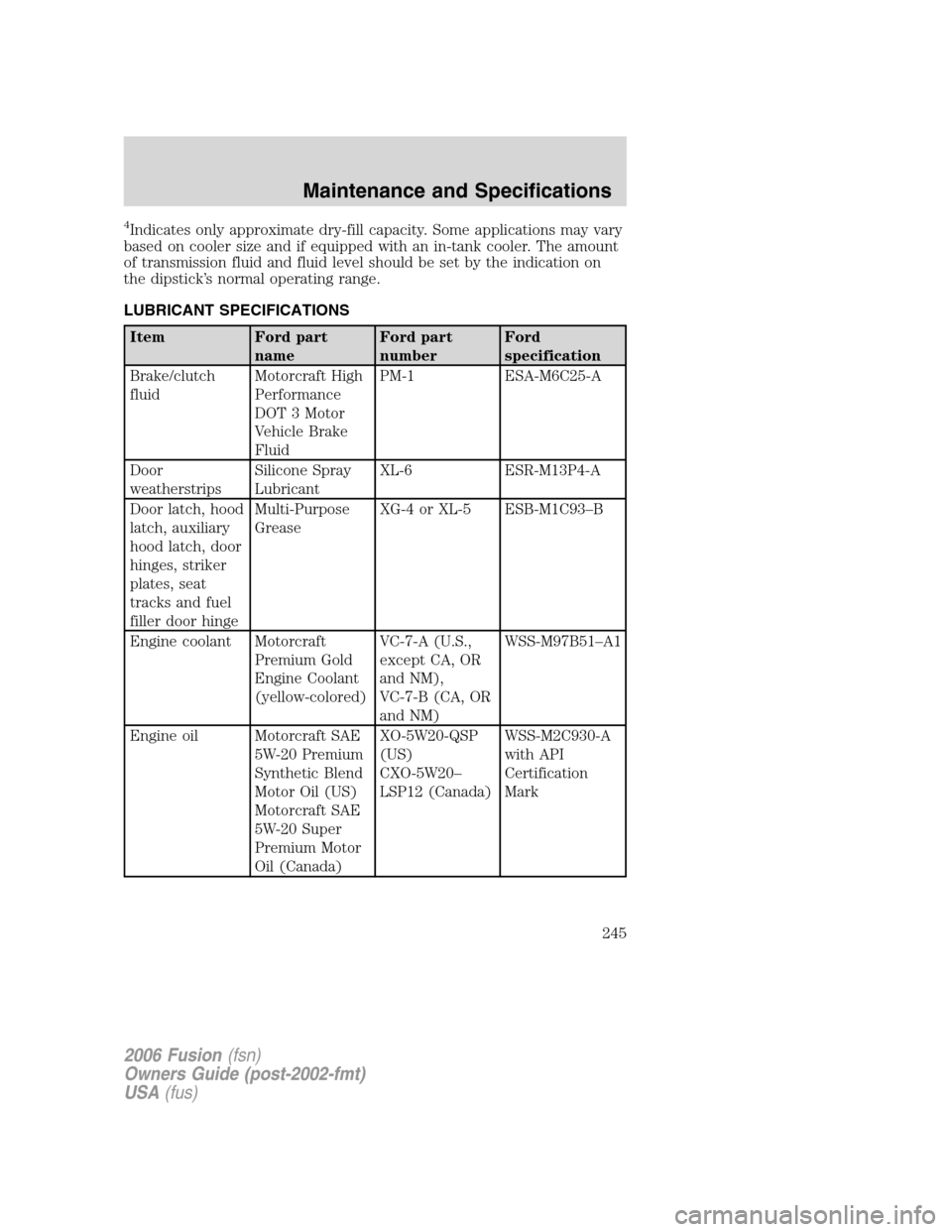
4Indicates only approximate dry-fill capacity. Some applications may vary
based on cooler size and if equipped with an in-tank cooler. The amount
of transmission fluid and fluid level should be set by the indication on
the dipstick’s normal operating range.
LUBRICANT SPECIFICATIONS
Item Ford part
nameFord part
numberFord
specification
Brake/clutch
fluidMotorcraft High
Performance
DOT 3 Motor
Vehicle Brake
FluidPM-1 ESA-M6C25-A
Door
weatherstripsSilicone Spray
LubricantXL-6 ESR-M13P4-A
Door latch, hood
latch, auxiliary
hood latch, door
hinges, striker
plates, seat
tracks and fuel
filler door hingeMulti-Purpose
GreaseXG-4 or XL-5 ESB-M1C93–B
Engine coolant Motorcraft
Premium Gold
Engine Coolant
(yellow-colored)VC-7-A (U.S.,
except CA, OR
and NM),
VC-7-B (CA, OR
and NM)WSS-M97B51–A1
Engine oil Motorcraft SAE
5W-20 Premium
Synthetic Blend
Motor Oil (US)
Motorcraft SAE
5W-20 Super
Premium Motor
Oil (Canada)XO-5W20-QSP
(US)
CXO-5W20–
LSP12 (Canada)WSS-M2C930-A
with API
Certification
Mark
2006 Fusion(fsn)
Owners Guide (post-2002-fmt)
USA(fus)
Maintenance and Specifications
245